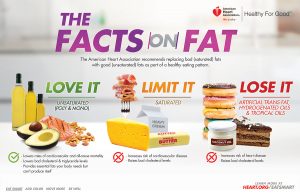Types of Fat
Fats tend to have a bad rep when it comes to weight loss, cardiovascular disease, and overall health. However, fats are an essential nutrient and play a role in many different functions throughout the body. Fats help to better absorb certain nutrients such as fat soluble vitamins (vitamins A,D,E,K), protect vital organs, support cell grown, provide energy, and help us feel fuller longer, just to name a few. What is most important when it comes to fat is the source and the amount consumed. There are four main sources of fat in foods:
- Saturated Fat
- Trans Fat
- Monounsaturated Fat
- Polyunsaturated Fat
Saturated Fat– These fats are molecules that have no double bonds between carbon molecules because they are saturated with hydrogen (which is not good for us in high amounts). These fats are typically solid at room temperature and are usually found in animal products. Too much saturated fat can raise LDL (bad) cholesterol, which could potentially increase risk of heart disease and stroke. The Dietary Guidelines for Americans recommend consuming less than 10% of calories from saturated fat, while the American Heart Association is stricter is their recommendations at no more than 7% of daily calories from saturated fat.
Sources include:
- Fatty beef
- Lamb
- Pork
- Poultry with the skin
- Lard
- Butter
- Cheese
- Whole dairy products
- Fried foods
Trans Fat– These occur when vegetable oils are chemically altered by adding hydrogen to stay solid at room temperature. This helps increase the shelf life and can also give food a more desirable taste and texture. Trans fats raise LDL cholesterol and lower HDL (good) cholesterol. High amounts can potentially increase risk of heart disease. The primary source of trans fats in processed food is partially hydrogenated oils. Avoid foods that have the words “hydrogenated” or “partially hydrogenated” listed, as these items will contain trans fats. It is important to note that foods can contain up to 0.5g of trans fat without having to be listed on the food label. So while you may think the food you are eating has no trans fats, it is possible that eating that item in excess could contain several grams of trans fat rather easily. It is best to limit consumption of these fats as much as possible.
Sources include:
- Some fried foods
- Frozen pizza
- Cookies, donuts, and other baked goods
- Stick margarine
- Biscuits and pie crusts

Monounsaturated Fat– These fats have a single carbon-to-carbon double bond, which results in fewer hydrogen atoms than saturated fat (which is good). This means that monounsaturated fats are considered a healthier source than trans or saturated fats. These fats tend to be liquid at room temperature and may help reduce LDL cholesterol levels, which can reduce risk of heart disease and stroke. There is no current recommendation for daily intake, however these should be consumed in place of more saturated and trans fat sources.
Sources include:
- Olive oil
- Canola Oil
- Peanut Oil
- Avocado
- Nuts
- Seeds
- Peanut Butter
Polyunsaturated Fat– These have 2 or more double bonds in its carbon chain, meaning it has fewer hydrogen atoms than saturated fat (a good thing). Most sources are liquid at room temperature, but there are still some more solid sources. There are two main types of polyunsaturated fats: omega-3 and omega-6 fatty acids, both of which have health benefits. Choosing more of these sources instead of saturated or trans fats can help lower LDL cholesterol and triglycerides. Both omega-3 and omega-6 fatty acids can help reduce the risk of heart disease and stroke.
Sources include:
- Salmon
- Mackerel
- Flaxseed
- Walnuts
- Corn Oil
- Sunflower Oil
- Sunflower Seeds

An easy strategy to help monitor overall fat intake is to look at the percentage of daily calories next to total fat and saturated fat on a nutrition label. Try choosing items that are 20% or less for these fats. And remember, try to choose items that are as low as possible in trans fats in order to keep cholesterol from becoming elevated. Fat itself should not be feared or cut out completely. The type of fat and overall amount is what is most important.
Resources
https://www.heart.org/en/healthy-living/healthy-eating/eat-smart/fats/dietary-fats
https://www.mayoclinic.org/healthy-lifestyle/nutrition-and-healthy-eating/in-depth/fat/art-20045550

